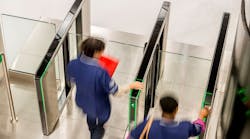Know Your Local Building and Fire Codes for Security Turnstiles and Doors
The evolution of modern security entrance code compliance began in flames and tragedy following the 1942 fire that consumed Boston’s premier nightclub, the Cocoanut Grove. It took less than 15 minutes for 492 people to die and another 166 to be injured in the deadliest nightclub fire in U.S. history. This was due to the main entrance being a single revolving door that became clogged and broken when patrons tried to escape.
The fact that today, nearly all corporate, hospitality, retail and government buildings employing a central revolving door today also use adjacent swinging doors within 10 feet is a direct result of this historical tragedy.
Security entrances, such as turnstiles and security revolving doors, are specialized types of entrances that work with access control systems to stop unauthorized entry in all types of buildings. They’re usually not intended to be the only means of emergency egress from a facility. But, in certain cases, they can contribute to your emergency egress plan and help ensure a safe evacuation.
Why are egress codes so important for entrances? According to the International Code Council (ICC), codes are a jurisdiction’s official statement on building safety—codes are a set of minimum standards to ensure the health, safety and welfare of the people. Codes address all aspects of building construction: fire, life safety, structural, plumbing, electrical and mechanical.
“Through time, people have become increasingly aware of ways to make buildings safer for occupants and avoid catastrophic consequences of building-construction failures. Resilient construction has the potential to substantially reduce property damage and loss of life,” says the ICC.
It was more than a single revolving door that led to the nightclub disaster. Contributing factors include:
-
Over-crowded conditions
-
Locked doors at other exits
-
Highly flammable decorations and props
Nonetheless, it was the issue with the main egress or door that grabbed headlines and prompted change for revolving doors in particular and emergency egress in general.
Strategic Approach Needed to Secure Entrances
Planning a security entrance egress plan can take several approaches. Manufacturers have implemented several built-in safety features to enhance security in emergency situations. Therefore, working with an entrance solutions provider and a security consultant or architect that understands the various building and fire codes is crucial.
Rule standards are established by organizations such as the National Fire Protection Association (NFPA) and the International Building Code (IBC), which are the primary entities that provide standards on the behavior of security entrances during an emergency.
Supporting standards and test methods are set forth by the American National Standards Institute (ANSI) and the Nationally Recognized Testing Laboratories (NRTLs), recognized as the standards by which compliance standards are set for security egress.
Setting the Standard for Secure Egress
The national standards for the comfort and safety of revolving doors are found in ANSI 156.27, American National Standard for Power and Manual Operated Revolving Pedestrian Doors.
This standard stipulates requirements for manual revolving doors, power-operated revolving doors and security revolving doors. The objective is to provide performance standards and provisions to reduce the chance of user injury and entrapment.
According to ANSI, the doors wing of a revolving door are required to bookfold or collapse when subjected to 130 foot-pounds (fps) of pressure by a user. This is to allow people to create an opening inside the door and freely escape—that opening has to be at least 36 inches wide.
The IBC 1010.1.4.1 has more to say about revolving doors: they can’t ever be the sole means of egress. Each revolving door must have a side-hinged swing door (that qualifies as an egress door per IBC 1010.1) within 10 feet of the revolver and that door must be on the same wall.
IBC further defines revolving doors into two types: those that are permitted to be included in egress calculations for a building and those that are not.
Permitted doors are manual revolving doors that don’t use any type of door wing locking mechanism during operation (automatic and security revolving doors are excluded from this category). They can be calculated to allow up to 50 people to evacuate per door. However, their clearance width (which again, must be at least 36”) can’t exceed 50% of the total clearance available from all of the doors allows by IBC for egress.
Not permitted are revolving doors that are locked into a position at any given time. These doors include automatic doors and security revolving doors. You will need to use other doors in calculating the means of egress, such approved swinging doors or manual revolving doors as described above.
“You should never try to use a regular manual or automatic revolving door that employs locking door wings to create a security revolving door,” explains Michael Poteet, Low Voltage Service Manager for Georgia at Pye-Barker Fire & Safety. “I was caught inside such a door a recently. I should have been able to force the door open, but could not. In this case, my entrapment could have closed off an entire wing of the building.”
Understanding Turnstile Egress
Much like revolving doors, turnstiles are also subject to strict standards. Turnstiles that do not exceed 39 inches in height can be credited for partial egress capability (up to 50 persons) but may not be the sole means of egress (there would need to have doors or gates with approved panic hardware installed on them).
Tripod turnstiles and full-height turnstiles can be set to freely rotate in an emergency to allow egress, however, IBC and NFPA codes do not permit these types of turnstiles to be placed where they would obstruct any means of dedicated pathway for emergency egress.
Optical turnstiles are categorized by NFPA as “security access turnstiles,” which are different than traditional turnstiles such as tripod and full-height turnstiles. Unlike traditional turnstiles, security access turnstiles can be considered a part of the means of egress if the building is protected by an automatic sprinkler system or fire alarm system.
In addition to specifics on minimum clear passages, optical turnstile barriers must:
-
“Automatically” retract into their cabinets or swing in the direction of egress travel
-
Have other means of egress nearby, such as pedestrian gates equipped with the appropriate egress component hardware allowing them to swing open
A knowledgeable architect or security consultant can aid the user in proper selection and more importantly, the placement of turnstiles in the building such that egress is as easy as possible.
According to IBC, to install and use a turnstile, the owner should provide a panic bar or exit button that would mechanically open a turnstile to allow egress. Typically, the manufacturers don’t include these controls, so it’s up to the integrator to assess the installation and determine what equipment they would need for each specific application.
The IBC specifically requires that if the turnstiles are in the established path of egress, the fire alarm system must be able to override the entrances and open them to allow egress. On the other hand, any access control entrances that aren’t part of the established means of egress may not require a life safety system to open them, but local authorities having jurisdiction will get the final say.
Bear in mind there is a simple workaround that the integrator could provide, which would be another means of egress (an approved swinging door or gate) next to the turnstiles that could allow for escape.
The Final Point
The bottom line for end-users is to make sure they have a Standard Operating Procedure established for the secure and safe operation of any secured entrance in their facility. Consult with the manufacturer regarding the working principle of the entrance during an emergency and their building’s occupancy and entrance requirements and then adjust the egress plans accordingly.
Steven DeArruda, a senior security systems designer for Business Protection Specialists, adds that by using a qualified security consultant for the Construction Contract Administration of a project, “they can oversee the process and ensure the proper procedures are being followed and the appropriate sign-offs are achieved during the process.”
Read Next: 7 Most Essential NFPA Standards for Building Owners


